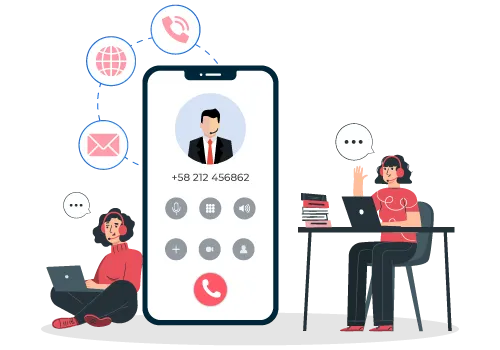Enhancing Real-Time Communication with Suppliers
One of the critical aspects of inventory management is communication with suppliers. Retailers often face delays in stock updates, restocking, or placing orders due to inefficient communication methods. Virtual numbers offer a simple yet powerful solution. By assigning dedicated virtual numbers to suppliers, retailers can easily maintain direct lines of communication, ensuring real-time updates on stock levels, shipments, or potential delays.
With virtual numbers, retailers no longer have to juggle multiple contact points or worry about miscommunications. These numbers can be linked to automated systems that notify suppliers as soon as stock falls below a certain threshold. This automation not only saves time but also reduces human error, ensuring the right products are ordered at the right time.
Improving Stock Accuracy through Automated Alerts
Keeping track of stock levels can be a challenge for any retailer, especially as businesses scale. Virtual numbers can be integrated with inventory management systems to provide automated alerts when stock levels drop, expire, or need restocking. By leveraging this feature, retailers ensure they always have the right amount of stock on hand without overordering or underordering.
For instance, a virtual number can be programmed to send SMS alerts to the warehouse team when a product is running low. This automation allows immediate action, reducing the risk of stockouts and lost sales. Additionally, automated alerts via virtual numbers can notify key personnel about inventory discrepancies, helping maintain accuracy across the supply chain.
Seamless Coordination Between Multiple Locations
Retailers with multiple store locations face the added complexity of coordinating inventory between different branches. Virtual numbers can help unify these operations by providing a single communication channel for all locations. Each store can use a unique virtual number to report inventory levels, enabling central management to have real-time insight into stock availability across the entire network.
By consolidating communication through virtual numbers, retailers can redistribute stock between stores, avoiding overstocking in one location while another runs out. This flexibility ensures that customers always find what they need, improving the overall shopping experience.
Simplifying Customer Queries About Product Availability
Customers increasingly expect retailers to provide real-time information about product availability, whether they’re shopping online or in-store. Virtual numbers can bridge the gap between inventory systems and customer service by enabling quick responses to inquiries. With virtual numbers, customers can text or call to check whether a product is in stock, ensuring a smoother shopping journey.
Retailers can also implement automated responses through virtual numbers. For example, a customer texts a specific virtual number asking about product availability, and the system automatically pulls data from the inventory system, providing an accurate, instant response. This approach reduces the burden on customer service teams while enhancing the customer experience.
Reducing Costs and Improving Efficiency
Traditional communication methods, such as landlines and personal mobile phones, can be costly and inefficient, particularly for growing retailers. Virtual numbers offer a cost-effective alternative that can be scaled as the business expands. Since these numbers operate via the internet, retailers can eliminate the need for multiple phone lines and minimize operational costs associated with communication.
Moreover, virtual numbers can be used to route calls to the right departments, ensuring quicker resolution of issues like stock discrepancies, returns, or restocking inquiries. This streamlining of communication not only saves time but also reduces labor costs by enabling faster and more effective problem-solving.
Streamlining Inventory Audits
Inventory audits are essential to ensure accuracy in stock levels, prevent theft, and manage shrinkage. However, audits can be time-consuming and labor-intensive. Virtual numbers can help retailers automate parts of the audit process. For example, auditors can text specific inventory updates or discrepancies to a central virtual number, automatically logging information into the system.
This streamlined approach eliminates the need for manual entry and reduces the chances of human error, speeding up the audit process. Additionally, virtual numbers can facilitate faster reporting of discrepancies between physical inventory and system records, helping retailers address issues before they become larger problems.
Boosting Supplier Relationships Through Transparent Communication
Building strong relationships with suppliers is crucial for retailers looking to maintain a steady flow of inventory. Virtual numbers enable clear, transparent communication by providing a direct line for suppliers to update retailers on shipment statuses, delays, or changes in product availability.
Suppliers appreciate retailers who are easy to communicate with and quick to respond. By offering dedicated virtual numbers for supplier communication, retailers demonstrate their commitment to efficiency and transparency, fostering stronger partnerships. This can lead to better pricing, priority service, and improved collaboration on inventory management strategies.
Facilitating Centralized Inventory Management
For larger retailers with multiple departments, warehouses, or even international operations, managing inventory from a single point of control is essential. Virtual numbers offer the flexibility to centralize inventory management. Each department or location can use a dedicated virtual number to report stock levels, place orders, or communicate with suppliers, with all data funneled into a central system.
This centralized approach ensures consistency in stock levels, streamlines ordering processes, and makes it easier to oversee inventory performance across the board. Retailers can adjust inventory strategies quickly, allocate resources more effectively, and respond to market demands with agility.
Future-Proofing Inventory Management
As retail continues to evolve, businesses must adopt technology that can grow with them. Virtual numbers are a scalable solution that can adapt to the changing needs of retailers, whether they are expanding their product lines, opening new stores, or diversifying their supply chains.
Because virtual numbers are not tied to a physical location or device, they can be easily reconfigured as businesses evolve. Retailers can add or remove numbers, integrate them with new systems, or scale up operations without disrupting inventory management processes.
Conclusion
Virtual numbers have the potential to revolutionize the way retailers manage their inventory. By enhancing communication with suppliers, automating stock alerts, simplifying audits, and centralizing operations, these digital tools offer retailers a cost-effective, efficient way to stay ahead in a competitive market. As retail businesses continue to grow and adapt to new challenges, virtual numbers will undoubtedly play a critical role in streamlining inventory management and improving overall efficiency.
About Us:
SpaceEdge Technology appears to be a term that might refer to a company, concept, or technology related to space exploration or utilization. However, without further context, it’s challenging to provide specific information.




